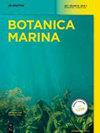Kapraunia silviae (Rhodomelaceae, Rhodophyta), a new species from the South Atlantic Ocean
IF 1.4
4区 生物学
Q2 MARINE & FRESHWATER BIOLOGY
引用次数: 0
Abstract
Kapraunia silviae(红藻科,红藻属),南大西洋的一个新物种
Kapraunia 是最近从 Polysiphonia sensu lato 中分离出来的一个属,目前已知的只有四个物种。然而,在南大西洋沿岸还没有发现任何物种。为了研究这些标本的身份,我们根据 COI-5P 和 rbcL 序列进行了形态学和分子研究。系统进化分析将我们的样本归入 Kapraunia 属,成为一个完全支持的新物种,在此描述为 Kapraunia silviae sp.该种与 K. pentamera 的不同之处在于附着形式、裂片比例和四孢子囊尺寸,与 K. schneideri 的不同之处在于四孢子囊周围细胞的数量、分枝的发育和四孢子囊的排列。对标本馆收藏的巴西老样本的重新检查也发现了将 K. silviae 误认为 "Carradoriella denudata "的情况。这个新物种似乎仅限于巴西海岸,只在圣保罗州北部海岸发现。我们的研究结果加强了对巴西海岸 Polysiphonia s.l. 物种进行修订的必要性。
本文章由计算机程序翻译,如有差异,请以英文原文为准。
求助全文
约1分钟内获得全文
求助全文
来源期刊

Botanica Marina
生物-海洋与淡水生物学
CiteScore
4.10
自引率
4.50%
发文量
43
期刊介绍:
Botanica Marina publishes high-quality contributions from all of the disciplines of marine botany at all levels of biological organisation from subcellular to ecosystem: chemistry and applications, genomics, physiology and ecology, phylogeny and biogeography. Research involving global or interdisciplinary interest is especially welcome. Applied science papers are appreciated, particularly when they illustrate the application of emerging conceptual issues or promote developing technologies. The journal invites state-of-the art reviews dealing with recent developments in marine botany.
 求助内容:
求助内容: 应助结果提醒方式:
应助结果提醒方式:


